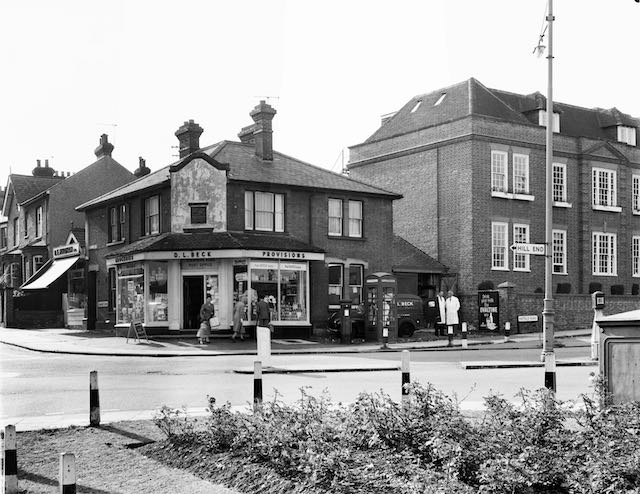A recurring theme in our range of absent images is turnpike toll payment houses. Here is another, which probably results from the frailty of such structures even when first erected. and of course the usefulness of their tiny sites once no longer required. It is understandable that photographs would be rare or non-existent; the structures were very basic and once the Reading & Hatfield Turnpike had been taken over as a county road in 1880 there was no further need for the infrastructure. So we are reliant on the attractiveness of a wider scene for an artist.
Homing in on the site of today's featured building we recognise it as the Indian restaurant Chilli Raj at The Crown corner, the current building replacing the former tollhouse known as the Chainbar Toll. An alternative name, the Fete Field Toll, was also in use during its lifetime, taken from the name of the home field of St Peter's Farm nearby.
A feature of sections of the Reading & Hatfield Turnpike was the number of side tolls; that is, locations where payments were made close to the junction of a lane or minor road just before entering the turnpike road. Although requiring more toll houses and therefore collectors than a system relying only on dividing the main road into sections, it may have been considered more fair to users; perhaps also more profitable for the owning Trust. From the turnpike trust's perspective it avoided users being able to make use of free sections until reaching the next main toll.
Throughout the life of the Chainbar Toll there was no Stanhope Road – this was still a cereal field called Hatfield Road field. Camp Road joined Hatfield Road exactly where it does today, where the Royal Mail posting box is located. Camp Road was the side road and therefore payment was due to entitle use of the section of the turnpike from that point as far as the Peacock public house at the junction with St Peter's Road. From then on payment was not required to travel through the city. The previous main toll was at Smallford – then called The Horseshoes – whose tollhouse was the subject of a recent post.
To protect the payment point at the little side toll at Camp Road, a chain was hung across the road from posts on either side. At certain busy toll points a separate lane was provided for traffic entering the side road since no payment was required, and therefore no chain. Abuse of this return lane was not unknown and it is presumed that the chain was drawn across this lane at the discretion of the toll keeper.
We know little of the toll keepers whose task it was to collect the fees. Except one, Sarah Gray, who lived in the cottage next to St Peter's Farm homestead on the other side of the Crown junction (where the Conservative Club is located today). She encountered Thomas Wheeler, who had just murdered Edward Anstee of Marshalswick Farm in 1880. Her testimony was reported in the Herts Advertiser, and the event would have been a mere matter of weeks or months before the abandonment of the toll system. Perhaps Sarah was relieved that she would no longer have to face the risks which must have been associated with her role.
Little detail is available about the toll building itself. We know it was residential and therefore contained at least one bedroom for permanent occupation. We also know that it faced directly onto Camp Road and its front looked directly along the line of Hatfield Road eastwards. The building was also very small. That's all.
As for when it was demolished the toll house probably remained empty until long after the development of the Stanhope Road estate had begun. One of the last buildings to go up was an impressive, though not extensive house on one of the then few plots at the eastern end. The house was built with a detached garage, which was later converted into a butcher's shop for Mr Bigg, and in the 1960s was taken over by Mr Holdham. The house itself was already shown as a Post Office on the OS 1897 map although does not appear to have been converted into a general shop until the 1920s; it incorporated the sub-post office. Which is why the post box occupies the adjacent spot today – and was once also partnered by a telephone kiosk.
There appears to be no visual evidence of the Chainbar Tollhouse left for us today. Travelling artists had produced sketches and watercolours, so perhaps one of the Chainbar Toll remains in a collection somewhere. This junction would have made a delightful scene for artist or early photographer.






No comments:
Post a Comment